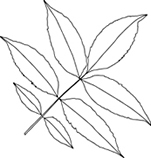Red or green ash
Frêne rouge ou vert
Fraxinus pennsylvanica Marsh.Oleaceae (olive family)Origin: Eastern North America (native in Ontario)

Origin: Eastern North America (native in Ontario)

Red or green ash is a medium-sized tree with leaves and branchlets with an opposite arrangement.
Read more about Tree, Bark, TwigsLeaves are pinnately compound with 5 - 9 leaflets branched off a central stalk.
Read more about LeavesMale and female flowers are tiny, lack petals, and are borne in dense clusters on separate trees.
Read more about FlowersFruits are winged seeds (samaras) that hang in clusters from female trees.
Read more about FruitTree shape is very variable. On open-grown trees the branches arch in an S shape to form a broad crown.
Twigs are greyish-brown and, along with the buds, are either densely hairy (red ash) or smooth (green ash).
Buds are rusty brown. The terminal bud is pointed, less than 8 mm ( 1/8") long, closely flanked by two small round lateral buds. Leaf scars are D-shaped.
Leaves are 15 - 20 cm (6" - 8") long, pinnately compound with 5 - 9 leaflets (usually 7), all but the terminal leaflet on a very short (0 - 5 mm), often winged stalk.
Leaflets are 10 - 15 cm (4" - 6") long, narrowly oval with tapered tips and bases, and sometimes small teeth on the edges from the middle of the leaflet to the tip. The underside of the leaflets are hairy (red ash) or smooth (green ash).
Fruits are winged seeds (samaras) that hang in clusters on female trees. This cluster also bears a dangling gall that has been formed by mites from sterile male flowers.
Fruits are yellowish or pale green, 3 - 6 cm (1 1/8" - 2 1/4") long, including a wing that is usually notched at the tip and covers at least half the seed.
Fruits mature to light brown in the fall and often remain on the tree in winter. This cluster is mixed with dark brown galls.
Distribution
Red or green ash is the most widely distributed ash in North America, with a natural range that extends from Saskatchewan to Nova Scotia, south to Texas and Florida. Green ash is more prevalent in the western regions of this range, particularly in prairie zones.
Derivation of names
The genus name Fraxinus is the Latin name for ash trees, and derives from the Greek word phraxix, meaning a separation. This refers to the European use of ash trees in hedges that divide properties. The species name pennsylvanica means of Pennsylvania.
Commercial use
The wood of red or green ash is used for many of the same purposes as the wood of white ash (Fraxinus americana), although the wood of white ash is generally preferred. Due to the similarities in the wood of these species, all their wood is typically marketed as white ash wood. Because of its strength, shock resistance, and bendable qualities, red or green ash wood may be used in the production of baseball bats and tool handles. Also, the ashes of burned red or green ash wood are used as a source of potash and red ash bark has been used to produce a red dye.
The threat of the emerald ash borer
Red or green ash, along with other native and introduced ash species, is currently threatened by the emerald ash borer (Agrilus lanipennis). This insect pest, brought from Asia, was first detected in the US and Canada, including the GTA, in 2002, and has already killed millions of ash trees. Ash mortality from this pest is expected to be on the scale of the decimation of North American elms from dutch elm disease and American chestnuts from chestnut blight in the 20th century. Removing and replacing dead ash trees will cost municipalities, homeowners, and businesses millions of dollars over the long term.Because of the threat posed by emerald ash borer, no ash trees of any kind should be planted until effective control and eradication measures are developed. Since the movement of ash wood products like mulch, firewood and logs significantly contributes to the spread of emerald ash borer, these products should not be transported from place to place.
For additional information including symptoms of infection, treatment and implications see: Natural Resources Canada factsheet and City of Toronto factsheet.
Wildlife value
Red or green ash's abundant seeds are an important food source during the winter for many species of wildlife, including quail, wild turkeys, squirrels, and cardinals. White-tailed deer are also known to browse on the twigs and leaves.
Related species
Red ash (Fraxinus pennsylvanica) and green ash (Fraxinus pennsylvanica var. subintegerrima) are nearly identical except that the leaves, leaf stalks, flower stalks, fruit stalks, and twigs of green ash are almost hairless, while those of red ash have dense hairs.
Green ash may be confused with white ash, which is also planted in urban areas as a cultivated tree. The best characters to look at to tell these species apart are the bark, the terminal buds and leaf scars on winter twigs, leaflet stalks, and fall colour.
Green or red ash's place in Toronto's urban forest
Both green and red ash were widely planted on streets and in parks in many urban areas in the 20th century, partly to compensate for the loss of American elms to Dutch elm disease, but also because of their tolerance to urban conditions such as pollution, drought, salt, and a wide range of growing conditions. The future of ash trees in Toronto is now uncertain because of the accidental introduction of the emerald ash borer (see above in Fascinating Facts). The City has begun a program of vaccinating thousands of trees on public land.
Landscape value and potential for home planting
Although red or green ash is very hardy and tolerant of urban conditions, no species of ash should be planted at this time because of the presence of emerald ash borer in our region.
Find trees on Tree Tour maps at Canadian Tree Tours: